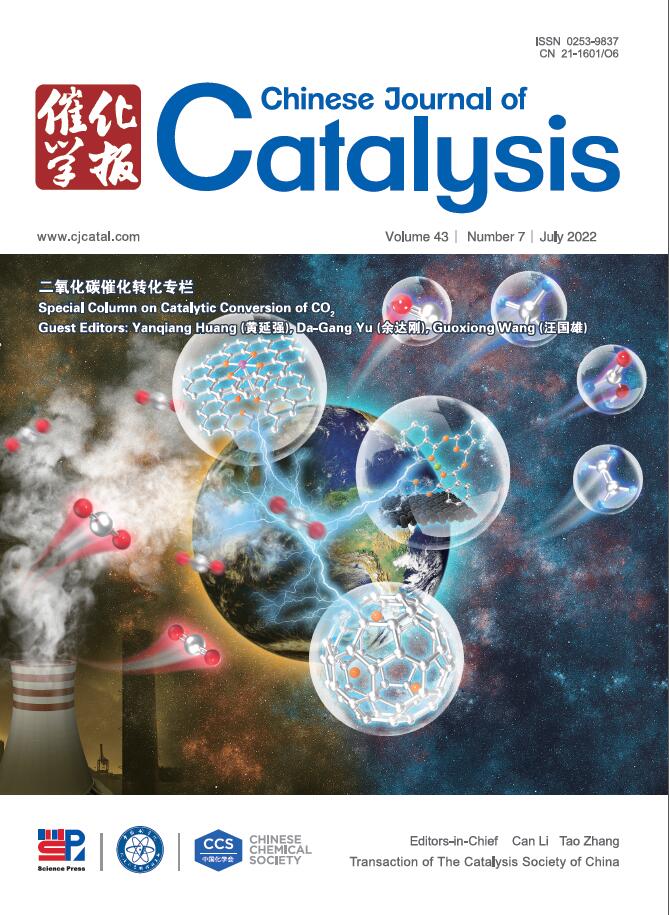Modulating electronic structure of g-C3N4 hosted Co-N4 active sites by axial phosphorus coordination for efficient overall H2O2 photosynthesis from oxygen and water
IF 17.7
1区 化学
Q1 CHEMISTRY, APPLIED
引用次数: 0
Abstract
Single-atom catalysts are promising for H2O2 photosynthesis from O2 and H2O, but their efficiency is still limited by the ill-defined electronic structure. In this study, Co single-atoms with unique four planar N-coordination and one axial P-coordination (Co-N4P1) are decorated on the lateral edges of nanorod-like crystalline g-C3N4 (CCN) photocatalysts. Significantly, the electronic structures of central Co as active sites for O2 reduction reaction (ORR) and planar N-coordinator as active sites for H2O oxidation reaction (WOR) in Co-N4P1 can be well regulated by the synergetic effects of introducing axial P-coordinator, in contrast to the decorated Co single-atoms with only four planar N-coordination (Co-N4). Specifically, directional photoelectron accumulation at central Co active sites, induced by an introduced midgap level in Co-N4P1, mediates the ORR active sites from 4e–-ORR-selective terminal –NH2 sites to 2e–-ORR-selective Co sites, moreover, an elevated d-band center of Co 3d orbital strengthens ORR intermediate *OOH adsorption, thus jointly facilitating a highly selective and active 2e–-ORR pathway to H2O2 photosynthesis. Simultaneously, a downshifted p-band center of N 2p orbital in Co-N4P1 weakens WOR intermediate *OH adsorption, thus enabling a preferable 2e–-WOR pathway toward H2O2 photosynthesis. Subsequently, Co-N4P1 exhibits exceptional H2O2 photosynthesis efficiency, reaching 295.6 μmol g–1 h–1 with a remarkable solar-to-chemical conversion efficiency of 0.32 %, which is 15 times that of Co-N4 (19.2 μmol g–1 h–1) and 10 times higher than CCN (27.6 μmol g–1 h–1). This electronic structure modulation on single-atom catalysts offers a promising strategy for boosting the activity and selectivity of H2O2 photosynthesis.
通过轴向磷配位调节g-C3N4承载Co-N4活性位点的电子结构,促进氧气和水对H2O2的有效整体光合作用
单原子催化剂在O2和H2O的H2O2光合作用中很有前景,但其效率仍然受到电子结构不明确的限制。在本研究中,Co单原子具有独特的四个平面n配位和一个轴向p配位(Co- n4p1)修饰在纳米棒状晶体g-C3N4 (CCN)光催化剂的侧边。值得注意的是,Co- n4p1中作为O2还原反应(ORR)活性位的中心Co和作为H2O氧化反应(WOR)活性位的平面n -配位剂的电子结构可以通过引入轴向p -配位剂的协同作用得到很好的调节,而Co- n4p1中只有四个平面n -配位的修饰Co单原子(Co- n4)。具体来说,Co- n4p1中引入的中隙水平诱导中心Co活性位点的定向光电子积累,介导ORR活性位点从4e—ORR选择性末端-NH2位点向2e—ORR选择性Co位点转移,并且Co 3d轨道d波段中心的升高加强了ORR中间*OOH的吸附,从而共同促进了H2O2光合作用的高选择性和高活性2e—ORR途径。同时,Co-N4P1中N 2p轨道p带中心的下移减弱了WOR中间*OH的吸附,从而使H2O2光合作用的2e -WOR途径成为可能。随后,Co-N4P1表现出优异的H2O2光合效率,达到295.6 μmol g-1 h-1,光化学转化效率为0.32%,是Co-N4 (19.2 μmol g-1 h-1)的15倍,是CCN (27.6 μmol g-1 h-1)的10倍。这种单原子催化剂的电子结构调制为提高H2O2光合作用的活性和选择性提供了一种有前途的策略。
本文章由计算机程序翻译,如有差异,请以英文原文为准。
求助全文
约1分钟内获得全文
求助全文
来源期刊

Chinese Journal of Catalysis
工程技术-工程:化工
CiteScore
25.80
自引率
10.30%
发文量
235
审稿时长
1.2 months
期刊介绍:
The journal covers a broad scope, encompassing new trends in catalysis for applications in energy production, environmental protection, and the preparation of materials, petroleum chemicals, and fine chemicals. It explores the scientific foundation for preparing and activating catalysts of commercial interest, emphasizing representative models.The focus includes spectroscopic methods for structural characterization, especially in situ techniques, as well as new theoretical methods with practical impact in catalysis and catalytic reactions.The journal delves into the relationship between homogeneous and heterogeneous catalysis and includes theoretical studies on the structure and reactivity of catalysts.Additionally, contributions on photocatalysis, biocatalysis, surface science, and catalysis-related chemical kinetics are welcomed.
 求助内容:
求助内容: 应助结果提醒方式:
应助结果提醒方式:


